I went into Evotinction about as cold as I could. I’d never heard of it before its PR rep showed up in my email with a PS5 code. I installed it anyway, and it turned out to be a near-future stealth/action adventure by the Chinese studio Spikewave Games.
It’s also one of those stories that doesn’t just start in medias res, but in a way that suggests you missed the first six episodes. The first 10 minutes of Evotinction are a tidal wave of strange allusions, story fragments, and new acronyms that get explained much later, if at all. It’s only after you’ve run a gauntlet of homicidal Star Wars toys that you’re given a real idea of what’s happening or why.
Evotinction is set in a top-secret research facility, where around 2,000 of the world’s leading scientists were recruited to a multi-discipline think tank. The goal was to build the future before it arrives, with the assistance of a fleet of autonomous drones that are produced on-site. You play as Dr. Thomas Liu, who leads the facility’s efforts in computer science and AI engineering.
On New Year’s Eve, a virus infiltrates the facility’s systems and shuts most of the staff inside their quarters, while the rest are quickly hunted down by infected security robots. Since he didn’t set his software updates to “automatic,” Dr. Liu is left as one of the last people free to move around the facility. With the help of some newly-installed neural chips and his AI buddy 0z, Dr. Liu must find a way to access and purge the computer core before the trapped scientists starve to death.
At its core, Evotinction is a pure stealth game. Dr. Liu is sealed inside a protective suit as a precautionary measure, but still can’t handle a straight-up fight with any of the drones. You’ll quickly find an improvised tool that you can use to overload and destroy a single drone at nearly point-blank range, but it’s got sharply limited ammunition.
You also start with the ability to remotely interface with computer systems through an augmented-reality rig in Liu’s suit. Early on, this is mostly good for opening doors, but you can gather materials from throughout the base that Liu can use to create new offensive software.

This includes forcing drones to turn, shutting off their visual sensors, or infecting them with a virus that will spread to everything else in their local communications network. However, each hack you perform in an area draws increasing attention from the base’s subverted security programs, and eventually they’ll lock down the area around you. Pure stealth is always your best option.
It’s a solid concept for an overall game, and Evotinction matches that with some solid graphic design chops for what’s ostensibly an indie. The first couple of hours of the game are set in a procession of warehouses and off-white sci-fi corridors, but once you’re finally done with the prologue, it breaks out into more visually interesting parts of the base like its entertainment center.
On the other hand, there’s a lot of general weirdness in Evotinction that I might have to chalk up to translation conventions. It’s oddly paced, with a “prologue” that’s about two hours long; it occasionally turns into a visual novel, where you’re given more background about Thomas Liu through plain text and dialogue choices; and it delivers its exposition like you’ve got its story bible open in your lap. It’s particularly bad about explaining the various too-clever-by-half acronyms that are used around the facility, like THIS, MORE, and HERE. If there was ever a game that needed a codex and tutorial in its inventory menu, it was this one.
The title is meant as a portmanteau of “evolution” and “extinction,” as a significant amount of the game’s running time is devoted to considerations of what it means to be artificially intelligent and its capacity for inflicting human damage. It’s picked a timely window in which to come out, but it also functions as a spoiler by itself. Once you know anything about Evotinction’s basic premise, the game’s entire second act hinges on a plot twist that you’ll see coming from a mile away.

For all that, I wouldn’t go so far as to say Evotinction is a bad game. It’s easy for the first couple of hours, as you’re simply finding your way around a bunch of slow-moving patrol drones, but once the game really hits the road it gets distinctly more challenging.
Soon you have to deal with a half-dozen drones at once in close quarters, security cameras that you can’t take offline without a specialized hack, and automated turrets that can spot you from across the room. Evotinction also primarily runs off Ubisoft-style stealth-game design, where the developers usually don’t provide a single intended route through any given room. Instead they throw a handful of enemies, assets, and obstacles into an area and expect you to figure it out on your own. Sink or swim, nerd.
I’d started playing Evotinction on the assumption that it’d be a lower-key sort of spooky game for the Halloween season. Instead, it’s a relatively hard science fiction story about the dangers of artificial intelligence. It could use another editing pass for its first couple of hours and some more in-game reference material, as right now it’s got some accessibility issues, but this is an overall solid production. It’s janky, but in a way that leaves me nostalgic for similarly weird games from early in the PS2’s lifespan. If you want something thoughtful, difficult, and largely non-violent, it’s worth a look.
[Evotinction, developed by Spikewave Games and published by Perp Games, is now available for PlayStation 5 and Steam for an MSRP of $29.99. This review was written using a PlayStation 5 code sent to Hard Drive by a Perp Games representative.]
This article is satirical. Hard Drive is a gaming/tech satire site. All content should be considered parody and entertainment purposes only.




